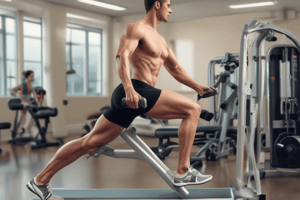Podcast
Questions and Answers
What is the primary purpose of applying AROM techniques as described in the text?
What is the primary purpose of applying AROM techniques as described in the text?
- To assess the patient's current level of active motion
- To strengthen the muscles by requiring the patient to actively move the limb
- To passively move the limb through its full range of motion
- To demonstrate the full range of motion available to the patient (correct)
When is assistance most likely to be required during AROM exercises?
When is assistance most likely to be required during AROM exercises?
- Assistance is never required during AROM exercises
- Whenever the patient is unable to complete the full range of motion
- At the beginning and end of the range of motion (correct)
- Only when the patient experiences pain
Which of the following is a benefit of using PROM techniques as described in the text?
Which of the following is a benefit of using PROM techniques as described in the text?
- Increased muscle strength
- Faster recovery time from injury or surgery
- Maintenance of joint range of motion (correct)
- Improved patient engagement and motivation
Which of the following upper extremity movements is NOT described in the text?
Which of the following upper extremity movements is NOT described in the text?
What is the primary purpose of performing PROM exercises in the side-lying or prone position, as described in the text?
What is the primary purpose of performing PROM exercises in the side-lying or prone position, as described in the text?
What is the primary function of the hand placement and procedure described for shoulder abduction and adduction exercises?
What is the primary function of the hand placement and procedure described for shoulder abduction and adduction exercises?
What is the primary purpose of self-assisted range of motion (S-AROM) exercises?
What is the primary purpose of self-assisted range of motion (S-AROM) exercises?
Which of the following is NOT a technique for self-assisted range of motion exercises?
Which of the following is NOT a technique for self-assisted range of motion exercises?
What is the primary benefit of performing passive range of motion (PROM) exercises?
What is the primary benefit of performing passive range of motion (PROM) exercises?
Which of the following techniques is described for performing passive range of motion for the shoulder joint?
Which of the following techniques is described for performing passive range of motion for the shoulder joint?
When might passive range of motion (PROM) exercises be contraindicated?
When might passive range of motion (PROM) exercises be contraindicated?
What is the primary purpose of the technique described as 'pushing both of the patient's knees laterally in one direction until the pelvis on the opposite side comes up off the treatment table'?
What is the primary purpose of the technique described as 'pushing both of the patient's knees laterally in one direction until the pelvis on the opposite side comes up off the treatment table'?
Which of the following techniques is used to assist the patient in performing active range of motion (ROM) exercises?
Which of the following techniques is used to assist the patient in performing active range of motion (ROM) exercises?
What is a potential benefit of using passive range of motion (PROM) exercises?
What is a potential benefit of using passive range of motion (PROM) exercises?
When might passive range of motion (PROM) exercises be indicated?
When might passive range of motion (PROM) exercises be indicated?
Which of the following is another potential use for passive range of motion (PROM) exercises?
Which of the following is another potential use for passive range of motion (PROM) exercises?
Which of the following techniques is used to facilitate active range of motion (ROM) exercises for the upper extremity?
Which of the following techniques is used to facilitate active range of motion (ROM) exercises for the upper extremity?
Which of the following techniques aims to reduce the resistance of gravity or friction during range of motion exercises?
Which of the following techniques aims to reduce the resistance of gravity or friction during range of motion exercises?




